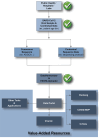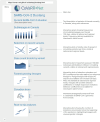The Canadian VirusSeq Data Portal and Duotang: open resources for SARS-CoV-2 viral sequences and genomic epidemiology
- PMID: 39401061
- PMCID: PMC11472881
- DOI: 10.1099/mgen.0.001293
The Canadian VirusSeq Data Portal and Duotang: open resources for SARS-CoV-2 viral sequences and genomic epidemiology
Abstract
The COVID-19 pandemic led to a large global effort to sequence SARS-CoV-2 genomes from patient samples to track viral evolution and inform the public health response. Millions of SARS-CoV-2 genome sequences have been deposited in global public repositories. The Canadian COVID-19 Genomics Network (CanCOGeN - VirusSeq), a consortium tasked with coordinating expanded sequencing of SARS-CoV-2 genomes across Canada early in the pandemic, created the Canadian VirusSeq Data Portal, with associated data pipelines and procedures, to support these efforts. The goal of VirusSeq was to allow open access to Canadian SARS-CoV-2 genomic sequences and enhanced, standardized contextual data that were unavailable in other repositories and that meet FAIR standards (Findable, Accessible, Interoperable and Reusable). In addition, the portal data submission pipeline contains data quality checking procedures and appropriate acknowledgement of data generators that encourages collaboration. From inception to execution, the portal was developed with a conscientious focus on strong data governance principles and practices. Extensive efforts ensured a commitment to Canadian privacy laws, data security standards, and organizational processes. This portal has been coupled with other resources, such as Viral AI, and was further leveraged by the Coronavirus Variants Rapid Response Network (CoVaRR-Net) to produce a suite of continually updated analytical tools and notebooks. Here we highlight this portal (https://virusseq-dataportal.ca/), including its contextual data not available elsewhere, and the Duotang (https://covarr-net.github.io/duotang/duotang.html), a web platform that presents key genomic epidemiology and modelling analyses on circulating and emerging SARS-CoV-2 variants in Canada. Duotang presents dynamic changes in variant composition of SARS-CoV-2 in Canada and by province, estimates variant growth, and displays complementary interactive visualizations, with a text overview of the current situation. The VirusSeq Data Portal and Duotang resources, alongside additional analyses and resources computed from the portal (COVID-MVP, CoVizu), are all open source and freely available. Together, they provide an updated picture of SARS-CoV-2 evolution to spur scientific discussions, inform public discourse, and support communication with and within public health authorities. They also serve as a framework for other jurisdictions interested in open, collaborative sequence data sharing and analyses.
Keywords: data sharing; evolutionary biology; mutational analysis; open access; viral genomics.
Conflict of interest statement
J.T.S. receives research funding from Oxford Nanopore Technologies (ONT) and has received travel support to attend and speak at meetings organized by ONT, and is on the Scientific Advisory Board of Day Zero Diagnostics.
Figures




Update of
-
The Canadian VirusSeq Data Portal & Duotang: open resources for SARS-CoV-2 viral sequences and genomic epidemiology.ArXiv [Preprint]. 2024 May 8:arXiv:2405.04734v1. ArXiv. 2024. Update in: Microb Genom. 2024 Oct;10(10). doi: 10.1099/mgen.0.001293. PMID: 38764594 Free PMC article. Updated. Preprint.
References
-
- Cameron R, Savić-Kallesøe S, Griffiths EJ, Dooley D, Sridhar A, et al. SARS-CoV-2 genomic contextual data harmonization: recommendations from a mixed methods analysis of COVID-19 case report forms across Canada. 2022. [9-April-2024]. https://www.researchsquare.com/article/rs-1871614/v1 accessed.
MeSH terms
Grants and funding
LinkOut - more resources
Full Text Sources
Medical
Miscellaneous

